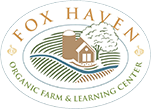Wild Soda and Fermentation with Lacey Walker
What a time of beauty and bounty! A pleasant lower humidity and clear skies met us for this Foragers 1 class. Lacey led us in continuing our discussion of Reciprocity, based on Robin Wall Kimmerer’s book, Braiding Sweetgrass, then introduced our topic and activity. We would learn the wild art of using fermentation to turn our fruit and herbal harvests into soda.

Blackberry
The paths, field, and garden were blooming and bursting with flavors, colors, and scents. We encountered wild Blackberry along the path. Lacey noted thorns up the back of the leaf stem that indicate the wild blackberry. She also noted the black spots, perhaps the result of colder nights late in the season, accompanying rain followed by hot and humid conditions the next day. Regardless of the origin, these spots indicate this may not be the year to harvest Blackberry leaves in this area. Every time you forage, the conditions of that year and that location can be different. Attention to the state of the environment and individual plants is important. Although she usually harvests Blackberry leaves for tea at this time, this year we didn’t harvest.
 Wineberry
Wineberry
My first taste of Wineberry was a burst of sweet flavor. Lacey noted identification markers such as the pointed leaves, and even fuzzier stems. She called our attention to the fact that there were not the similar issues on the Wineberry leaves as we had seen on Blackberry leaves.
Our next stop was Fox Haven’s intercropped orchard, which was brimming with herbal goodness. Lacey led us in meeting herbs with our senses, and learning some of the ways they have traditionally supported humans. We smelled, tasted, and felt each one, and chose one or two to harvest for our wild soda.
 Yarrow
Yarrow
It’s easy to see why Yarrow’s bright white flowers, with their agreeable faintly honeyed scent, are beloved by pollinators. Yarrow is known to be a bitter-tasting dispersive when taken internally, which can aid the liver and digestion. Topically, it can be a first-aid support to assist in clotting blood or help with bruising.

Wormwood
Wormwood is also a bitter perennial herb that can help to disperse stuck heat, or energy, to aid the liver and digestion. Lacey noted that Wormwood is customarily used in small doses for shorter periods of time. Fox Haven harvests flowers for a local distillery’s Absinthe spirit as well. I’ve never worked with Wormwood before, but I was taken with its silvery gray leaves, and decided to harvest a small piece to use in my wild soda.
 Echinacea
Echinacea
The row of Echinacea blooms smelled magnificent and their pink beauty was medicine for the eyes and soul. Echinacea is a lymphatic stimulant that is helpful at the beginning or end of an illness. It is also helpful for bee stings, muscle injuries, and can be a great addition to wild sodas.
 Bee Balm: Monarda fistulosa and Monarda didyma
Bee Balm: Monarda fistulosa and Monarda didyma
We saw both purple and red Bee Balm. The red Bee Balm (Monarda didyma) has a citrusy aroma and taste. Purple Bee Balm (Monarda fistulosa) tastes slightly floral with a sweet undertone, along with a slightly bitter peppery flavor, reminiscent of thyme. Its taste and energy is a bit stronger, which can hit you with a big stimulating impact, but leave you feeling calmer.

 Mullein
Mullein
Tall majestic Mullein leaves are helpful for a respiratory complaints such as dry cough. Its flowers can be infused in oil for eardrops, and the root has been reportedly used by some for lumbar or lower sacral pain. Several classmates harvested a few flowers for their soda.
Harvest art by our classmate.
 Soda-making Time
Soda-making Time
We headed back into the Barn with our harvest to learn more about fermentation and soda-making. Lacey noted the wide range of fermented sodas made throughout the world, ranging from Tepache in Mexico to Sweet Potato Fly in Guyana and Smreka in Bosnia.
Soda can be made with different fermenting agents, including those which use naturally occurring yeasts and require no additional starter. I was surprised at the range of possible added starters such as bread or champagne yeasts, whey, or water kefir. The possibilities for creative herbal, fruit, spice, and starter combinations are endless.
Under Lacey’s guidance, we combined our harvested herbs with warm water, sugar, and starter. My Wormwood concoction quickly took on a silvery green hue and the red Bee Balm soda turned a light pink.
 The day after our Saturday class I noticed a light fizz and transferred my soda into bottles to continue fermenting on the counter before transferring them to the fridge.
The day after our Saturday class I noticed a light fizz and transferred my soda into bottles to continue fermenting on the counter before transferring them to the fridge.
On Tuesday, I worked outside for several hours and decided the hot weather was perfect for drinking the slightly carbonated soda. The red Beebalm smelled citrusy and tasted deliciously light.
But the Wormwood soda was my favorite. The bitter was balanced by the sugar and gave it a satisfying edge.
I can’t wait to try out new wild soda combinations!
 Written by Charis Han-Storms
Written by Charis Han-Storms
Charis is studying herbalism, foraging, and gardening under amazing teachers at Fox Haven Farm, Retreat & Learning Center, Sacred Plant Traditions, and Wild Ginger Herbal Center.
She is thankful for all the women, from a variety of traditions, who cultivated relationships with the plant world and preserved this knowledge and path for future generations. She spends an inordinate amount of time checking on seedlings, searching for new books at the library, and exploring gardens and wild places.
